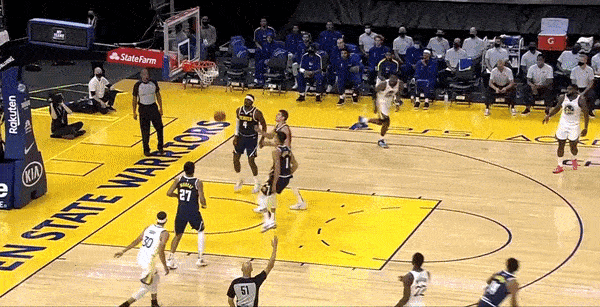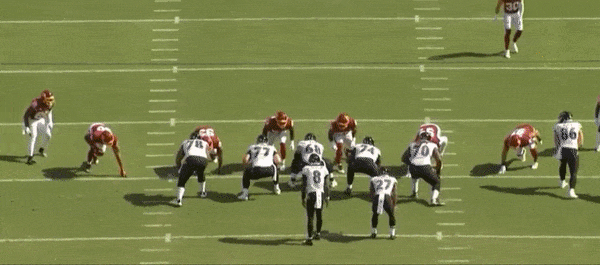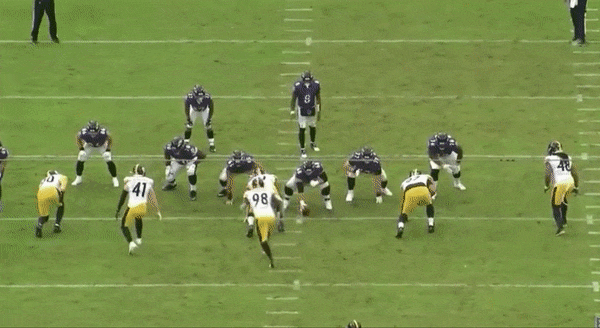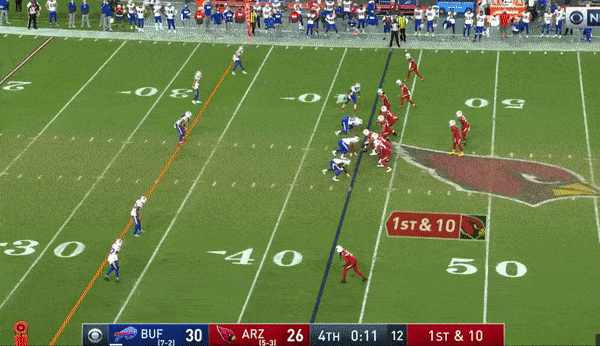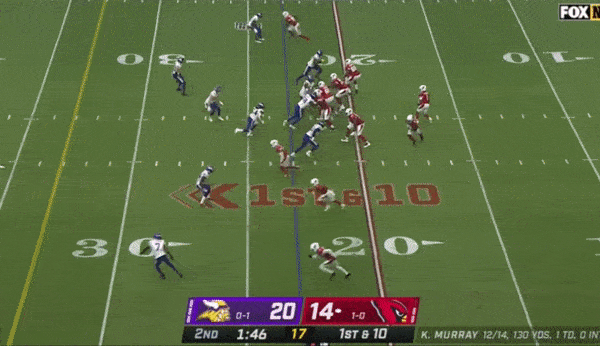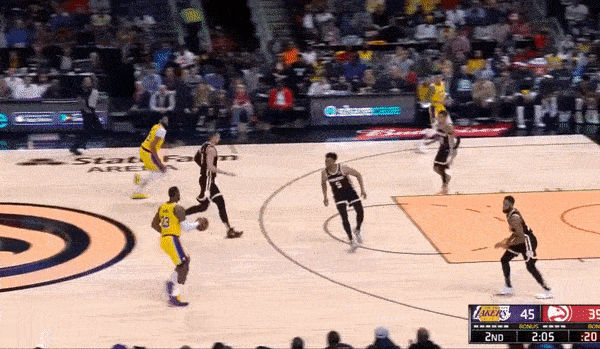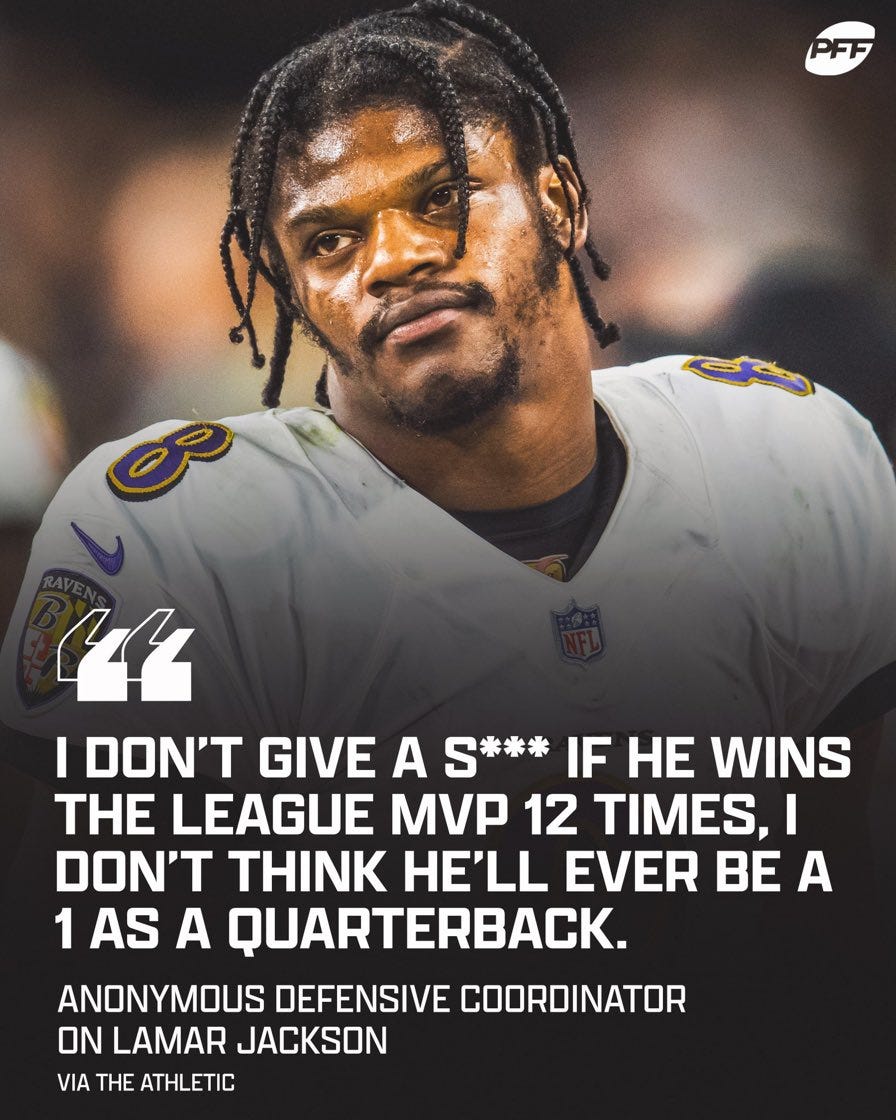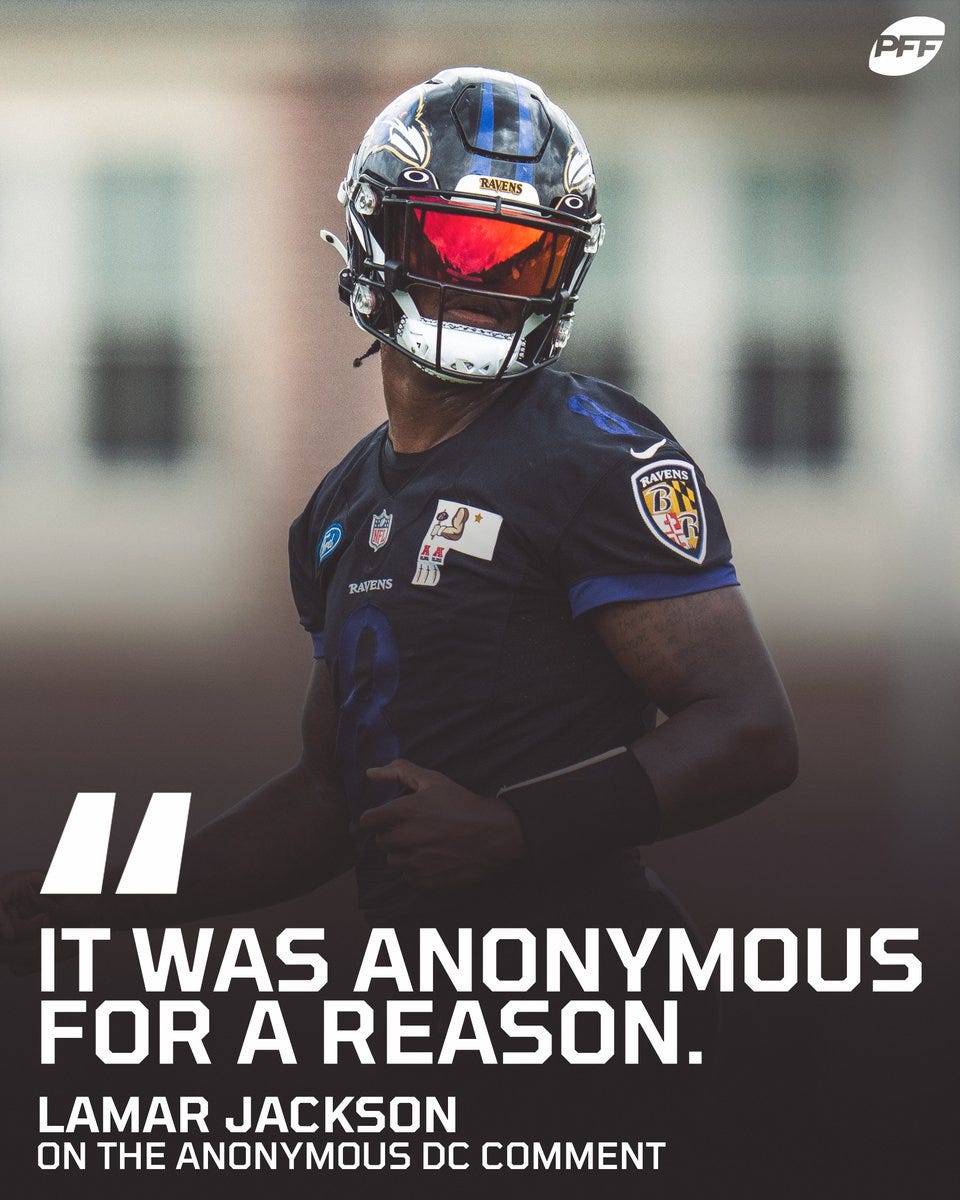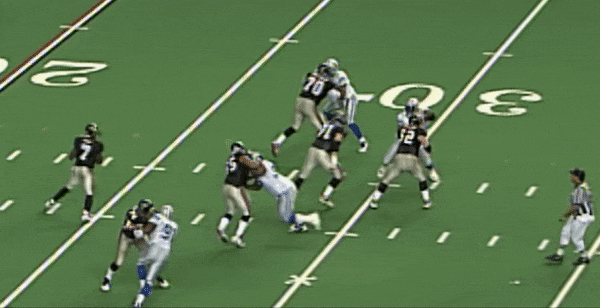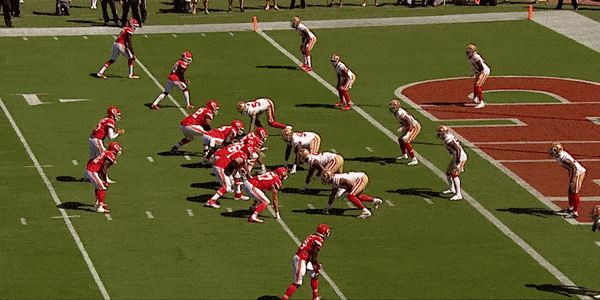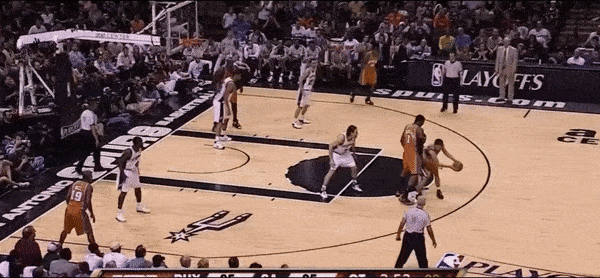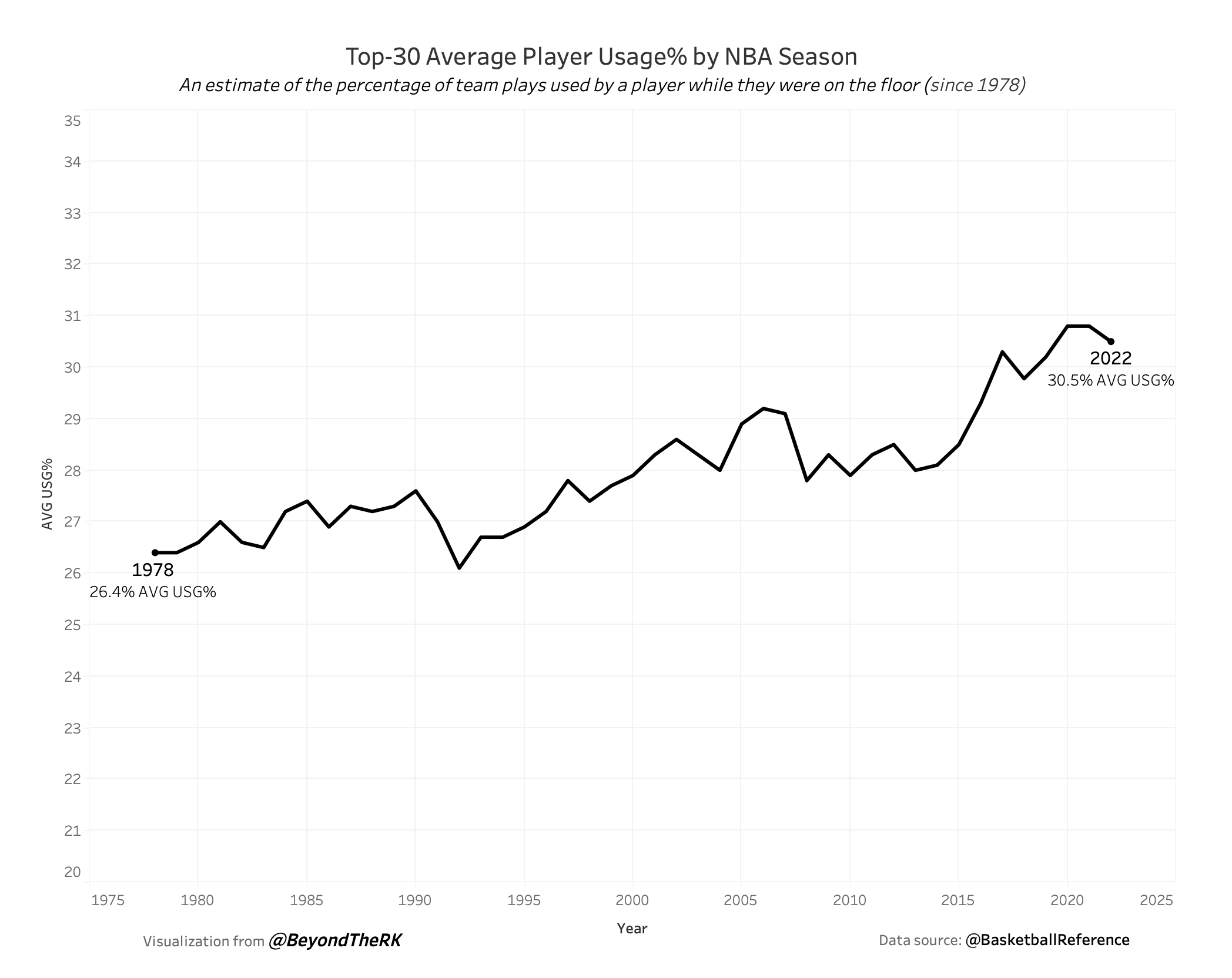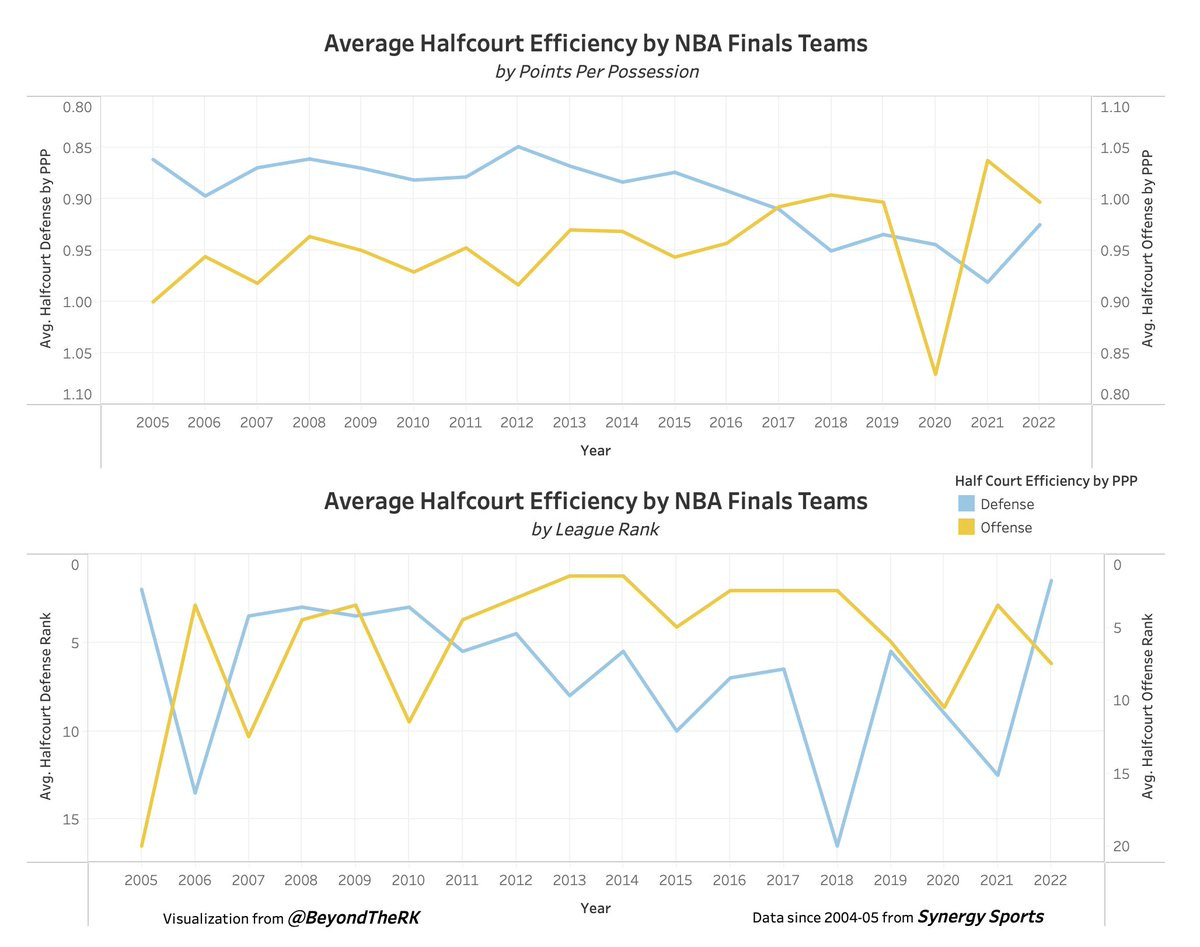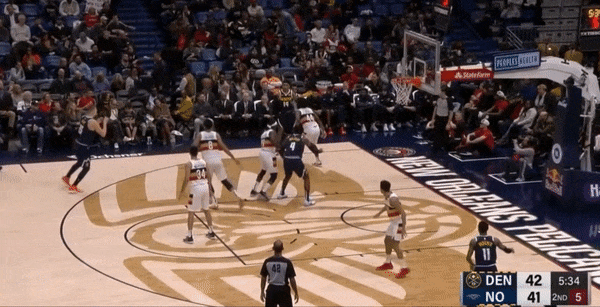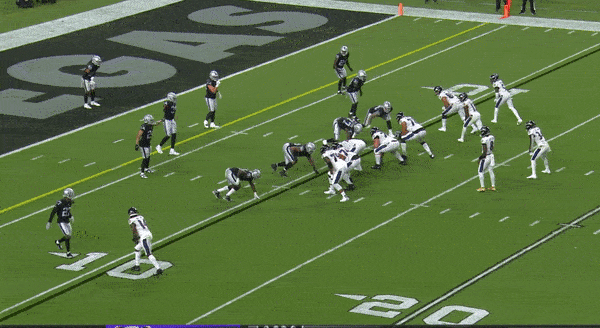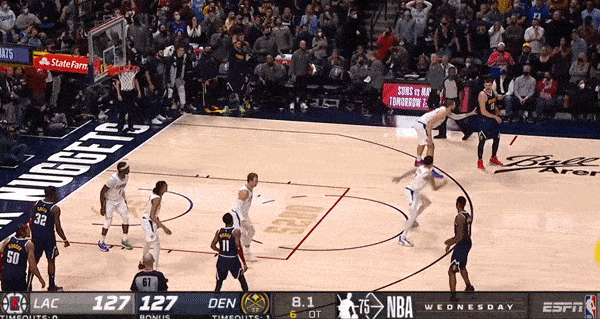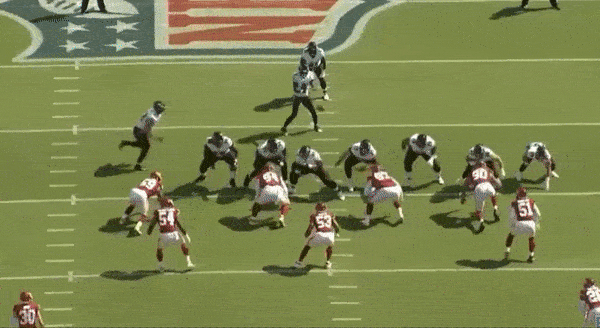The Scoring Creator
How on-ball decision-makers in basketball and football use the threat of attacking defenses directly to create advantageous scoring opportunities for the entire team.
What do Lamar Jackson and Nikola Jokic have in common?
On top of a handful of shiny MVP trophies, Lamar Jackson and Nikola Jokic share cerebral super powers as scoring creators, allowing them to break down defenses and act on open angles at a moment’s notice. Their teams’ entire identity is built on the decision-making execution of their star player, with the fate of the franchise relying on one human being consistently reading defenses, processing options, and reacting right away to either attack themselves or create a scoring opportunity for others.
At their best, sports can be a symphony of ever-moving parts blended together into a disorganized funk, where the beauty pops in expecting the unexpected. Fans wait for the artist to drop a mean bassline with a no-look shuttle-pass, dazzling spin-move, or forceful downhill attack to break the rhythm of the beat.
Quarterbacks and point guards are often praised as the “second coach on the floor” for knowing the playbook inside and out and having a strong feel for the game. Compared as leaders with the vision, talent, and skill to set the tone and table for every player on the team; the stereotypes of the creator, the distributor, the playmaker.
The floor general is responsible for curating the best play possible for the team based on what the defense gives up. Traditionally, the goal of this point maestro role is to set up others for scoring opportunities by finding a hole in the zone or a mismatch to exploit. While making the right play is sound, few sights produce as many oohh’s and aahh’s as a decision-maker going against the grain of the play by attacking the basket, shooting a tough shot, or darting a difficult dime.
What happens when the team’s premier creator for others is simultaneously the team’s best primary scoring option? What if the team’s best chance to put points on the board is through the lead decision-maker choosing to attack individually or use the threat of that attack to bend the defense and open opportunity for others?
Scoring creators combine footwork and balance with perceptive strengths like pattern recognition, parallel processing, and processing speed to make immediate decisions, with the spatial awareness to stay aware of all relevant movement happening on the field of play and the cognitive load to juggle all the incoming inputs at once.
What separates the average scoring creator from a superstar is the consistency to do it all again the next play.
Kyler Murray drops back and rolls out; as he surveys the field, the defense is asked to do the impossible: contain the quickest athlete in the stadium without losing any receivers now freestyling to break open in a scramble drill. When the twitchiest speedster on the field can locate his targets on the run, it’s time to break some eggs.
Murray has such strong hand-eye coordination, he had the option to go pro in baseball; instead, he stuck with football. Kyler shows off his foot speed and processing speed when keeping plays alive while keeping his eyes down field. Usually buying time by running figure eights in the backfield, Murray’s ran over forty yards before completing a pass twice in the NFL, according to Next Gen Stats.
During Kyler’s “first eight weeks of 2021 before the injury, Murray graded out at 90.3 PFF on plays outside of structure, the highest mark in the league, while handling the fourth-most such snaps,” according to PFF.
How different are Kyler Murray’s read-and-react responsibilities as a quarterback who can throw on the run or take off running compared to the decision-making process of a basketball player like LeBron James picking up his dribble on a drive to the rack to bend the defense and create a scoring opportunity for himself or others?
Scoring creators deconstruct the game in live time, recognizing patterns by reading defensive coverageto to decide whether the best play for the team is to attack the defense individually or pass to a teammate, with the talent to actually pull it off. These dual-threat talents possess the mental dexterity and hand-eye coordination to transform cognitive thought into athletic action, the proprioception to control their own body movement with balance, and the mental capacity to keep track of everything going on.
Without pretending to know everything that goes on inside the mind of the pro athlete, what we can compare is how the human brain functions in decision-making. How the combination of analyzing defenses, picking the best option, and executing with precision takes layers of symmetry to turn imagination into reality.
“The brain can be viewed as a muscle that has stamina, a muscle that can be trained.” - Evan Zaucha shared with Ben Taylor on this recent Thinking Basketball podcast on related topics.
Currently working in Basketball Operations at @SISHoops, Evan Zaucha wrote a staple piece on feel in basketball, relating neuroscience nuances to basketball actions on the court.
Let’s ask Evan to help compare a few hypothetical situations for on-ball decision-makers in basketball and football who threaten to attack defenses individually.
Q: How does the thought process of a quarterback scrambling who can run or throw compare to a basketball player ISO driving-and-kicking or going downhill in transition?
EZ: “I think the sense of pressure and the focus on keeping eyes up to ingest all the ongoing action as visual stimulus and make the best decision possible as the defense shows their hand are the key similarities.
A ballhandler dribbling downhill who knows he can either pull up and shoot it or find a high value pass is very similar to a QB who can either keep or throw, and that unpredictability positively impacts chances of success against a defense because they have to plan for both.”
Q: How does the decision-making process of a P&R ball-handler compare to a QB rolling out of the pocket during a play-action set?
EZ: “The processes are very similar because they're both acquisition of information leading into decision making while leveraging ability to keep options open.
The QB or ballhandler must read how the defense is reacting in near real time, assess the options present to them (keep or throw to each viable receiving option), and make a decision while potentially attempting to draw out defensive decisions or open up an option not previously available.”
Q: How are these decisions changed when sped up with pressure from a blitz or trap?
EZ: “Blitzes and traps are specifically designed to make the quarterback or ball handler feel a greater than usual sense of pressure that causes them to make a decision before they're ready or inaccurately assess the other variables in the problem (pass receiver openness especially).”
Key Terms from The Art and Science of Feel in Basketball, by Evan Zaucha
Pattern Recognition - Awareness
Games can be broken down into possessions and possessions can be broken down into actions and schematic decisions on both ends of the court. Pattern recognition is the ability to observe all variables in these “problems” and apply broader templates to them, usually gleaned from past experience, as a heuristic to decrease the amount of time the brain takes to come up with a solution.
Your brain is applying hierarchical plans to the sequencing of your behavior every time it solves a motor problem (Lashley, 1951).
Visual Procession - Assessment
Basketball is a game where parallel processing – the ability to be aware of and process multiple stimuli that are all actively changing – is key. Visual processing is the ability for the human eye to decode information from visual stimuli and convert it to understandable and actionable information for the brain.
Spatial awareness is a specific genre of visual processing that also incorporates proprioception – otherwise known as our ability to perceive the position and movement of our own body through space.
Spatial awareness is key in both the planning and execution stages of movement. An athlete with a high level of spatial awareness can accurately diagnose how big a passing window is and therefore how long it will be open while simultaneously directing his limbs to execute the perfect live dribble pass to take advantage of that window.
Processing Speed - The Action
Processing speed is the rate at which the brain encodes information from exterior stimuli, processes that information, and begins to respond.
Q: With the streetball comments the past few weeks & Kyler Murray’s contract, do you think you’re evaluated differently because you’re a black quarterback?
A: I don’t want to go that far and say that. I mean, obviously the black quarterback has to have a battle to be in this position that we are, to have this many guys in the league playing. I think every day we’re proving that we should’ve been playing the whole time. We’ve got guys that think just as well as they can use their athleticism, so it always is weird when you see guys like me and Lamar (Jackson), Kyler (Murray) kind of get that on them and other guys don’t, but at the same time we’re going to go there and prove ourselves every day to show that we can be some of the best quarterbacks in the league.” - Patrick Mahomes, Kansas City Chiefs Media Day

The perfect storm for a professional sports franchise involves everything from vertical alignment between star, coach, GM, and owner to the star players’ surrounding help on the roster, expected role and responsibility, and opportunity to succeed.
Freedom to make mistakes is vital for long-term development.
When the fastest and strongest humans alive masterfully understand the sport they’re playing, a professional job starts looking a lot more like a pickup game in the backyard. When the only thing left to do is play the game they’ve mastered, athletes become artists; Michael Jordan becomes Michaelangelo with the rock in his hands.
Quarterbacks who can read and react on the fly to win a play, a quarter, or even a full game on individual talent, no matter what scheme or situation lies ahead, bring an x-factor that can overcome almost any odds.
One of the most electric sights to see in sports, Patrick Mahomes has been slinging the pill in high-octane offenses going back to his collegiate days. Yet, nine teams didn’t see enough from him at Texas Tech to see into the future; Mahomes fell to 10th in the 2017 NFL Draft, where the Chiefs traded up to select him.
How did this dynamic gunslinger go from not-a-sure-thing to household name? Mahomes found himself in an ideal situation to maximize his powers, where his talent, opportunity, and team investment aligned.
Spending his first season on the sidelines, Patrick Mahomes was able to study an already prolific offensive system ran by QB Alex Smith up close. The very next season, Pat’s first as full-time starter, Mahomes dropped a boombastic 50 TD-12 INT and 5000 Yard statline, entering rarefied air only shared by Peyton Manning and Tom Brady.
In their superbowl-winning season, the Chiefs offensive roster was stacked. At the time, Kansas City featured possibly the best offensive line in the league, the NFL’s quickest speedster in Tyreek Hill, arguably the best tight end in Travis Kelce, and the quarterback-whispering offensive play-calling mastermind, Andy Reid.
Andy Reid has held a reputation as an innovative offensive coach for decades. However, Reid had to spend most of his career hearing how his high-speed west coast systems were too cute to hold up in the NFL — until they dominated the NFL.
Starting out as an offensive coaching assistant with the Green Bay Packers the same year Brett Favre joined the roster, Reid would be promoted to Favre’s quarterback coach as Brett ripped off 3 straight MVPs and 5 Pro Bowl appearances with Reid on staff. Andy worked up the ranks to a head coaching opportunity in Philadelphia, building effective offenses around quarterbacks Donovan McNabb and Michael Vick.
The ‘04 Madden game-breaking cover athlete blazed the trail as an attack-first scoring creator who could beat you on the ground or in the air, first running laps around the NCAA at Virginia Tech before taking his talents to the Atlanta Falcons.
Michael Vick would put up the best passing seasons of his career in Andy Reid’s air-it-out system in Philadelphia. Bursting out of the gates with a league-leading 6.8 yards per attempt on one hundred rushes in 2010, his first season as full-time starting quarterback for the Eagles, Vick posted a 21 TD - 6 INT ratio and 100.3 passer rating while rushing for another 9 TD and winning the division.
Shrugged off as a running quarterback whose inaccuracy wouldn’t last at the pro level, Mike Vick completed over 60% of his passes for 2800 yards per season in a 3-year span in coach Reid’s air-it-out offense, with highlight-reel speedsters turning corners on the edges like Desean Jackson and Lesean McCoy. The team answered criticisms around the coach, system, and player meshing in a way that could reduce erratic decisions and controllable turnovers.
Since taking over in Kansas City in 2013, Andy Reid has stamped his spread scheme with the approval of a superbowl ring while never posting one losing season, winning 77% of his regular season games for an average of 14 wins per year along the way.
Mahomes dropped in, took the dual-threat torch, and ran with it. Just 19 games into his short career, Patrick Mahomes ranked first in the league on plays outside the pocket with a 94.2 passer rating, completing 92 of his 166 passes for a total of 1,325 yards, 17 touchdowns, and 4 interceptions.
Before the 2019-20 NFL season began, PFF graded the top-five quarterbacks on plays outside the pocket, requiring “a minimum of 50 or more passes on designed rollouts and scrambles over the last three seasons, including the playoffs.”
During that 2020 season, Mahomes led the NFL with 146 pass attempts outside the pocket for 16 touchdowns and 0 interceptions, according to Sharp Football Analysis.
Patty Ice only gets cooler under pressure.
“Nine quarterbacks had at least 50 passing attempts (against pressure) outside the pocket (in 2020), including the playoffs. (before the superbowl)
Mahomes was the only one with positive EPA.
Pressured outside the pocket doesn’t exclusively mean pushed out from pressure, but those plays are included. Pressure outside the pocket can be a play in which the quarterback was already outside and pressure came late. Either way, Mahomes is the outlier with positive performance.” - Sharp Football Analysis
Some downplay the lone title as an outlier season, pointing to Mahomes’ all-time great impact being provided to a team on a rookie salary in a salary-capped sport, allowing Kansas City to load up elsewhere. Russell Wilson found similar success delivering a championship on a rookie deal in Seattle with the loaded Legion of Boom defense; was Russ ever viewed as any less of a star as the Seahawks defense aged out of their prime?
It’s unfair to expect anyone to put up Brady-to-Moss type numbers every year. Even with touchdown totals relatively “slipping” from 50 to 26, 38, and 37, Mahomes’ completion percentage has stayed at a career average of 66%, and he’s totaled over 4000 passing yards every year along the way.
“Getting the ball out faster, making the right decision, not hanging on that one read,” Mahomes told Kevin Clark when summing up lessons learned from last season.
Other than maintaining unrealistic success at the top of the sport, Patrick Mahomes truly has nothing left to prove on the individual level. Are these last few seasons closer to Mahomes’ true talent level without the advantages of an elite O-Line, skill position firepower, and lack of tape for other teams to scout? Are we sure we’ve seen the best from Mahomes, or was his first year as starting QB just the perfect storm?
While few thoughts are as horrifying as lining up in an Oklahoma drill against large steel safe-sized human beings like Aaron Donald or Khalil Mack, the most lethal weapon a football team can holster on its roster is an accurate, mobile quarterback. To be more specific, it’s a QB who can pick you apart with his arm, his mind, and his feet.
For dual-threat stars like Lamar Jackson, Patrick Mahomes, Kyler Murray, Josh Allen, and OGs Mike Vick, Donovan McNabb, and Randall Cunningham, that means being noticeably more athletic than the fastest and strongest athletes in the world, while also being able to toss fifty yard dimes on the run.
For a traditional pocket passing legend like Tom Brady, the outlier who defies father time, mobility extends to the footwork and awareness needed to stay moving in the pocket long enough to keep a possession alive or throw the ball away to avoid a turnover and save clock.
When accounting for the mental side of the game, defining “athleticism” and “mobility” gets blurry. The range for athletic mobility between dual-threats and pocket-passers boils down to the same goal: stalling for time using movement within the pocket versus rapidly scrambling outside of it; intentionally extending the play with one’s feet.
Teams like the Ravens, Chiefs, Bills, and Cardinals thrive off the ever-present threat of their quarterback breaking ankles on the ground or needling throws through the air at any given moment. This risky style doesn’t seem to hurt these teams even when falling behind, since Kansas City and Baltimore rank 1st and 2nd respectively with the highest successful play percentage when trailing since 2019, via PFF.
Who’s to say where the ideal combination lies between herky-jerky quickness, throwing accuracy on the run, and pocket mobility? Here’s a look at the wide range of pass locations from the last four quarterbacks standing in 2020: Aaron Rodgers, Josh Allen, Patrick Mahomes, and Tom Brady, via Michael Lopez and NextGenStats.


The right mix of unpredictable execution and matchup versatility can make an offense unguardable. Some teams are so talented that they win games even when opposing defenses know exactly what’s coming, yet still can’t stop them.
Play-action works best when the offense poses a legitimate threat to run the ball, with the loud secret being that you don’t actually have to establish the run first to freeze the secondary into making a split-second decision. Pick-and-rolls and DHO basketball sets create a similar downhill-option dilemna for defenses as play-action and RPO sets in football, like when both the ball-handler and roller have penetrated the paint as the drop defender freezes up while deciding whether or not to break up a lob or goaltend a floater.
There’s only so many ways to use the threat of a quarterback’s talent as an off-ball tactic, like double-reverse passes and one-off Wildcat sets. In hoops, however, the threat of Steph Curry shooting exists as soon as he walks over half court, ball in hand or not.
The nightmare that the best shooter to ever play can BANG! a three-pointer at any second horrifies opponents to a degree that even a Derrick Henry play-action can’t inspire. Steph Curry terrorizing defenses as a scorer on the ball while constantly relocating his shooting gravity around the arc when off the ball would be like NFL defenses having to worry about Lamar Jackson throwing fifty yard bombs to himself.
“I probably should have shot the ball twenty times a game,” says Steve Nash, retrospectively pondering his pass-first mindset as a player. Nash’s two MVPs reveal how valuable his shot creation felt in the eyes of award voters and how memorably exciting his high-paced Seven Seconds or Less Suns’ playstyle was to watch for fans.
The only sport Steve Nash loves as much as basketball is soccer. Growing up on the pitch, even talking futbol on the tele in his post-NBA career, Nash has long been enamored with the complex puzzle-solving of high-speed playmaking, how to put teammates in the best position to score, and the diversity of downhill-weaving attacks that an aligned cohesive unit can pull off on a breakaway.
Nash-led offenses posted historic offensive ratings in Phoenix under the free-wheelin’ run-n-gun style of Head Coach, Mike Dantoni. Dantoni and Nash are credited for embracing the spread pick-and-roll and pushing the pace for easy looks rather than clogging the paint with post ups, as Dantoni has long been regarded as an offensive innovator who allows star talent the freedom to improvise and play freely. In 14 of his 15 seasons as an NBA Head Coach, Mike Dantoni’s teams ran up a higher pace (more offensive possessions per game) than the average offense.
The Suns would find themselves sprinting forty-eight minute marathons, pushing opponents through a never-ending suicide drill with endless pick-and-rolls inbetween. Steve would seemingly keep his dribble alive forever: driving through the paint, past the defense, and down the baseline, all while surveying the floor for open shooters, as Amare Stoudamire soars to the rim for the lob threat after setting a mean screen to initiate all the action.
Ben Taylor describes this advantage creation as “creating a power play” when breaking down the intricacies of the pick-and-roll in his phenomenal book, Thinking Basketball. By attacking the paint and drawing the attention of defenders, scoring opportunities for teammate arrive. Ben defines the effect of a player’s actions on his teammates and himself as the Global Impact of that player:
“Since the goal of a team is to outscore its opponent, individual success on offense is not dictated by how many points that individual scores, but instead by how many points he helps himself and his teammates score…
Individual scoring is not replaced, it is redistributed.”
- Ben Taylor, Thinking Basketball
From age 27 to 36, Nash dished out 10 assists while scoring 17 points on a nightly basis, shooting an absurdly efficient 50-44-91 from the field. That high efficiency is begging for an increase in volume; a rate that would bring Nash to just under 30 PPG had the efficiency stayed level with an increase in volume to 20 shots per night. Steve Nash shot 3.7 threes per game in that span; for comparison, Steph Curry launches a career average of 2.2 threes, every quarter.
The closest real-world answer to this what-if would probably be James Harden. In the Beard’s peak offensive seasons (2017-2020), Harden shot over 21 times per game, with none other than Mike Dantoni coaching from the sideline. Harden dropped 32 points per game, shooting 36-44-86 on 21 field goals, 11 threes, and 11 free throws, filling the a box score every night with averages of 9 assists, 7 rebounds, and 2 steals.
Those Rocket teams constructed by Daryl Morey broke offensive ratings at the time, consistently racking up efficient offensive looks at the rim, the line, and from deep. The offense flowed through Harden first and foremost, surrounded with plus-defenders like rim-rolling rim-protector Clint Capela, secondary closeout-attack threats like Eric Gordon, and D&3 wings like corner specialist P.J. Tucker.
The best version of those Rockets teams featured two seasons of Chris Paul, allowing the team to play at least one future hall-of-fame guard creator on the floor at all times. CP3 bridged league eras from Nash’s to Harden’s, embodying what a scoring creator is capable of when willing to use the threat to attack as a weapon in the arsenal. When the point god is snaking pick-and-rolls for spinning middies, lofty lobs, and no-look dimes, all the defense can do is pray.
If anyone’s taken the reigns as the league’s marquee heliocentric scoring creator going forward, it’s Luke Doncic, who’s off to a legendary start to an individual career. Every play runs through Doncic in Dallas, yet when his mastery of the game, versatile scoring profile, and all-seeing vision shines every possession, why wouldn’t it?
Putting up post-season numbers few have ever seen, Luka Magic has no offensive ceiling. Doncic’s regular season averages of 28 points, 9 assists, 9 rebounds, and 1 steal per game are already a near nightly 30-point triple double, shooting 47-34-75 on 9 3PA in 192 contests. Luka only grows stronger in the postseason, upping his scoring average to 33 points, with 9 rebounds, 8 assists, and 1 steal per game, while shooting 47-37-69 on over 10 3PA per game through 28 playoff games.
Somewhere between the NBA’s growing talent pool, the average player having a deeper bag than before, and the rule changes opening up the floor, there appears to be more bucket-getters in the NBA than ever before.
94 players scored at least 15 PPG in 2021-22, by far the most ever.
76 players scored at least 15 PPG in 2019-20, the previous high.


Before 2022, only six players in NBA history had ever won both a scoring title and an assist title throughout the course of their career. This past season, however, Atlanta’s Trae Young became the first player to lead the league in total points and total assists in the same year since Tiny Archibald in 1972-73, via Sports Illustrated.
Back in 1977, the year of the ABA merger, eight players averaged 15 PPG & 5 APG, according to Basketball Reference.
In 2022, thirty five players hit average marks of 15 points and 5 assists, via NBA Stats.
While imperfect, another way to measure the increase in a team’s scoring creation load through the league’s top players is usage percentage, an estimate of the percentage of team plays used by a player while they were on the floor.
Since 1978, the average of the top-30 player usage percentages has slowly increased from 26% to over 30% this past season (2022), via Basketball Reference:
Imagine if the sport arrived to a place that encouraged the primary decision-maker to look for his own shot when evaluating the best option for the team back when Steve Nash played, before Steph Curry broke the sport, rather than poo-pooing pull-up jumpers from point guards all together. A player like Nash would feel like he’s breaking an unwritten rule, the point guard code, if he “selfishly” dared to look at the rim instead of the pass.
Like LeBron before them, stars such as Luka, Harden, and Trae have been given heliocentric responsiblities, where the entire offense relies on individiual decision-making; however, not all scoring creators look the same. The Warriors have constructed an entire offense revolving around the threat that a 3pt sniper like Steph Curry can launch from anywhere at any moment.
By taking the ball out of Steph’s hand on an every-play basis, the Warriors don’t depend on one player’s decision-making possibly creating erratic results, even while playing a loose uptempo style. Instead, defenses have to guard the action at hand while always worrying about the relocating splash bros delivering the kiss of death.
Would Nash’s absurd shooting efficiency stay on nuclear levels with increased volume, where he’d take and create as many shots as score-first on-ball creators like the peak James Harden Rockets or today’s Luka Doncic Mavs or Trae Young Hawks?
Drift back to the hero’s journey arc of Michael Jordan’s storied career. His head coach, Doug Collins, was using PPP (points per possession) back in the ‘80s to show Jordan’s absurd scoring efficiency, while Michael won every individual award available, even becoming the first NBA player to win MVP and DPOY in the same season.
The only problem was that Jordan’s Bulls weren’t winning in the playoffs.
Before everyone wanted to be Like Mike, before Jordan Brand went global, he was a guy named Michael, heckled as just another me-first chucker whose ISO style would never be enough to win the big prize. MJ would play out of his mind individually, like his legendary series against an all-time great ‘86 Celtics team, only to get swept. Jordan’s Bulls were bounced out of the playoffs by Isiah’s Pistons three years in a row, detailing some of the postseason struggles MJ faced on his rise to immortality.
After seven seasons in the NBA, a 27 year-old Michael Jordan finally reached the mountain top, slaying the IT Pistons and Magic Laker dragons in his path. MJ won his first championship; then another the next year; then another the year after that. Jordan then “retired” for a year and a half, returning midseason only to lose to the Shaq and Penny Magic in a playoff series, before ripping off another three straight titles alongside Scottie Pippen, Dennis Rodman, Toni Kukoc, and Steve Kerr.
That’s six rings, two threepeats, in eight years, for those keeping track at home.
What caused Jordan’s Bulls to flip the switch?
Chicago’s new triangle offense engaged everyone in the rotation while spacing the floor. Everyone kept moving and everyone touched the rock, staying engaged even when everyone and their mother knew Mike was taking the last shot.
Not to simplify everything to a new scheme, ignore player development, or overcredit a coaching change, but one factor was clear: Previously an offense relying around the individual scoring efforts of its superstar, leaving everyone else in stand-and-wait-to-see-what-Michael-does mode, the new system implemented by Head Coach Phil Jackson now required players and the ball to stay in motion.
On top of the six titles in Chicago, Jackson went on to win five more rings with the Lakers coaching Shaquille O’Neal, Kobe Bryant, and Pau Gasol around the same triangle offense, balancing the ego management of stars with those same stars finding their spots within the system. The right mix of scheme, motivation, and roster balance can help unlock a cohesive unit out of individual talents.
The Duncan-Popovich Spurs dynasty integrated european style ball-movement to the NBA, a franchise contending for over two decades built on the ideas of trust between teammates, spacing the floor, penetrating the paint, and instantaneous decision-making through Coach Pop’s “point-five second” rule to dribble, shoot, or pass.
Tim Duncan’s humble coachability as a superstar created a baseline of expectations for his entire team. With the help of Manu Ginobli, Kawhi Leonard, David Robinson, and Tony Parker, the Spurs sustained one of the NBA’s longest standing dynasties, with Timmy serving as the franchise’s beacon of light. The star player getting in line for a team-first system built on ball-movement sets the tone for everyone.
Steph Curry wasn’t any less skilled before Steve Kerr arrived, but maybe the gravitational threat of his shot wasn’t pressuring defenses to the same degree, at least off the ball. Where Mark Jackson established an elite defense, Steve Kerr unlocked a juggernaut spread offense out of a roster built by Bob Myers, forming a movement-centric behemoth of switchable 6’7” team-first-decision-making plus-defenders flanking the brightest offensive star in basketball.
Other than Jerry West and Pat Riley, there aren’t many people with as much experience next to basketball greatness than Steve Kerr. As a player, Kerr suited up next to all-time greats in Michael Jordan, Shaquille O’Neal, and Tim Duncan, learning about floor-spacing ball-movement systems up close under the tutelage of coaches Phil Jackson and Gregg Popovich, where the goal of involving everyone on the team was emphasized.
Later taking over the reigns of GM for those Nash Suns teams, Kerr saw the challenges in extending a contender’s window up close, with Nash, Stoudamire, and Shawn Marion near their primes. Spending some time in the booth, his enthusiasm and understanding of the game shined as a color commentator all the way into the NBA 2K video game franchise. Now the Warriors’ head honcho on the sidelines, Steve Kerr has coached Steph, Klay, Draymond, Kevin Durant, and Andre Iguodala through the ups and downs of contending with continuity.
Playoff teams like the Bulls and Warriors reached dynastic levels once offensive-minded coaches Steve Kerr and Phil Jackson took over, replacing coaches who had built elite defensive teams around arguably the two best scorers to ever hoop. By taking the ball out of their superstar’s hands and replacing it with ball-movement and motion schemes, everyone on the bench was kept involved to maximize engagement on both ends, improving teams that perennially made the playoffs but seemingly hit ceilings as legitimate contenders to win them.
Emphasizing team-first ball-movement elevated one-way perennial playoff pretenders to true two-way contenders through the power of team comraderie, by building an offense around the threat of the team’s best scoring option, using that threat to create advantages for the team like easier scoring opportunities for others, rather than relying entirely on the high-usage, and possibly erratic, decision-making of one individual.
Would these teams have still won rings had the coaching changes, motion schemes, and emphasis on the team not been introduced? It’s possible; it’s not like the core talent saw wild annual turnover, until the three year sport-breaking arrival of Durant to Golden State occured, giving the best offense basketball had ever seen more hall-of-fame scoring options than not in its starting unit.
KD’s a walking gliding bucket with a nearly unblockable smooth shot release and an unstoppable middy pull-up. Doubling one of Steph, Klay, or Kevin meant leaving another one open; good luck. Countless systems could win with that talent in hand; but the culture Golden State built through a free-flowing ball-movement style had an undeniable effect on maximizing talent in-house and attracting talent elsewhere.
The dynasty started long before Draymond called Durant from the parking lot. Two playoff teams with elite defenses led by all-time great ISO scoring superstars in the Bulls and Warriors got knocked out of the playoffs repeatedly until embracing a floor-spacing ball-moving offensive scheme that kept everyone involved, ultimately defining the legendary careers of Jordan and Curry.
Golden State’s motion-centric offense seems like a viable option for other teams, though it requires buy-in from skilled shooters willing to run around endlessly knowing they might not ever see the ball. Here we are, four championships into the Dub Dynasty, yet no teams are even comfortable playing the same spread off-ball motion style, let alone believe they can win in that fashion without the reliable orbit of Steph and Klay bouncing around Draymond’s handoff and pindown screen setups.
Nowadays, heliocentric offenses can be found all over the association. How well will that strategy work over a seven game series when one team has Nikola Jokic, LeBron James, or Luka Doncic running the show and the other team doesn’t?
Style and scheme success are dependent on situation and talent.
For awhile after Michael Jordan retired, every team tried to find The Next Jordan, building their teams around ISO midrange specialists who never quite lived up to the hype. Kobe Bryant of course came the closest, embodying Michael in nearly every way, from dazzling fadeaway footwork down to post-game interview mannerisms.
Legends of the game like Larry Bird and Tracy McGrady are two examples of rare talents who could do just about anything with a basketball. Point-forwards like Scottie Pippen and Grant Hill were lengthy playmakers on the wing, while supersized point guards Oscar Robertson and Magic Johnson paved the way. Yet, today’s trend of fully heliocentric offenses is mostly credited to the success of LeBron James.
LeBron jumped from high school to the league, eventually proving a team can win with the entire offense running through one person as a decision-making bucket-getting point-man. As legendary as ‘09 D-Wade was at his peak, the Heatles reached theirs once LeBron took over as the defacto first option. Cleveland has five NBA Finals appearances because LeBron brought them to five Finals as the primary option to score, draw a foul, or drive and kick on nearly every offensive possession.
Giannis Antetokoumnpo later lept onto the scene, racking up every accolade in the book. As a seven-foot point-forward? point-center? Giannis remains the most unstoppable transition force of nature on the planet, with a case as the league’s most versatile defender to boot.
While acknowledging his next-level individual impact, just about anyone who watches the Bucks would agree their halfcourt offense looks cleanest with Khris Middleton using his pull-up shooting threat to run the action as ball-handler mixed with Jrue Holiday’s secondary attack, unleashing Giannis as the greek-freakiest rim-roller alive with his tough-shot making sprinkled in.
Even though Antetokoumnpo has been the clear best player on the team for years, impacting nearly every play on both ends when he’s on the floor, he realized during their title run that taking the ball out of his own hands, becoming an apex play-finisher, would give his team the best chance to score, and ultimately win. Giannis capped off a memorable playoff run with a dominant NBA Finals-clinching 50-piece in Game 6 for his first championship ring.
Are schemes effective because of the talent driving the wheel, or is a player’s production maximized by the scheme? Can non-LeBron heliocentric creators truly contend for a championship, or will the ask become too much over a long series against playoff defenses?
One similarity shared by champions like the Bucks and one-time-champs-turned-dynasties like these all-time great Bulls, Lakers, Spurs, and Warriors teams is a clear and concerted effort to involve the entire rotation, to embrace “the other guys”, to engage everyone on the team to maximize easy opportunities and effort. This trait may not be a prerequisite for winning, but from Russell’s and later Bird’s Celtics, to Moses and Dr. J’s Sixers, to Isiah’s to Chauncey’s Pistons, the theme reigns true: great players don’t win championships; great teams do.
For squads that rely solely on the self-creation of stars, rather than an offensive system that orbits around the threat of the star’s strengths, there’s reason to believe that a limit can exist to the burden on the body, that a player can only take so many hits, drives, and shots before there’s a wearing-down effect, especially over the course of a deep playoff run, even for the most reliable anchors.
Competing to making the playoffs is one challenge; contending with a chance to win is another all together. While LeBron has shown heliocentric scoring creators can win the big prize with enough firepower around, is it realistic for other teams to think they can recreate that model of success with a player who is not LeBron James?
Players with elite feel have shown to create efficient offense consistently as the sole proprietor of their team’s shot-creation. Could stars like Luka, Trae, or Harden see similar benefits that Michael saw once the head coach took the ball out of the star player’s hands and turned up the volume on team-first ball-movement, or would a lack of off-ball effort and roster help stifle positive tradeoffs?
Creating good looks against regular season teams is one challenge, where analytics can be utilized to help coaches, players, and teams win on the edges, especially for racking up good possessions against average or worse competition. Finding reliable, efficient offense against playoff defenses scouting your every move, however, is a different story; when the first, second, third options are closed off, what’s the plan?
In spite of “living and dying by the three”, ball-movement schemes built around the endless off-ball motion of Steph and Klay actually create a sustainable system that doesn’t overtask the individual; as long as the splash bros are willing to run around the arc, dragging their shooting gravity along with them, defenses stay living in fear. Since 3PT shots don’t hit every night, results can look more volatile than normal, but as the legendary coach Jeff Van Gundy once said — “it’s a make or miss league.”
Surprise, surprise: Grant Williams thinks his Celtics team was the more talented Finals squad. Grant goes on to credit the Warriors’ championship pedigree of decision-making experience on the biggest stage for the victory, saying the difference wasn’t an advantage in talent, but in discipline.
How Golden State creates the same good shots for players who make those shots on a consistent enough basis, where the decision-making load is divided up into an off-ball relocation machine that spits out the same looks every time down, rather than a heliocentric offense relying on one person making a good decision for the team nearly one hundred times per game.
While offensive players tend to be the biggest stars, a team can ride an elite team defense deep into the post-season. Playing a rotation of players with few holes in their game, like plus-defenders who can dribble, pass, and shoot, affords a coach multiple options who rarely hurt their teams when on the floor, offering matchup versatility.
The 2022 NBA Finals featured the highest-ranked halfcourt defensive matchup since at least 2005, when data became available.
2022: Boston Celtics ranked 1st and Golden State Warriors ranked 2nd
2005: Detroit Pistons ranked 1st and San Antonio Spurs ranked 3rd
From defensive end to corner back, high-impact players exist at every position on a football field. Bulldozing running backs and field-stretching receivers can misdirect defenses. A bad offensive line unit can sink the strongest group of skill positions in the league, whereas an elite, gap-opening offensive line unit gives offense the ability to run just about any play scheme they want.
Defense still matters; slowing down these offensive artists is as vital as ever. Football teams can ride an elite defense and competent offense all the way to a superbowl. Good running teams wear down defenses, control the clock, and rarely turn the ball over; good passing teams pick up first downs faster in chunk plays, with a more volatile form of quick-attack. While running plays bring perks like making second and third down more manageable, passing plays tend to pick up more yards in a hurry.
What matters most is not how a team scores points, but how many points the team scores. All of these offensive styles are viable paths to moving the chains and putting points on the board, as every talent and scheme mesh in their own ways. Finding good, dependable offense is the ultimate goal, a set of actions executed by a team’s best players that consistently creates an opportunity to score or advance the ball into scoring position.
The most-valued and most impactful individuals at the top of the sport today are game-changing quarterbacks who can a win a game on their own by affecting nearly every offensive possession they’re on the field for. The only player even allowed by the rules to create scoring opportunities for themselves and others by bending defenses on a football field is the quarterback.
While the point guard is often referred to as the quarterback on the court, this premise works for any position in basketball, since having the handles, scoring chops, and passing skill to create for yourself and others translates to every level. As roles become blurred and players become more versatile on both ends, however, it’s clear offensive hubs can be formed at any position, even if the positives of having a good half-court decision-maker at point guard remain true.
Players can guard one position on defense and fill a non-traditional role on offense, or better yet, be capable of filling multiple roles to help the team in a myriad of ways on either end. Like Draymond Green and Bam Adebayo, Joel Embiid is the defensive anchor and best screen-setting handoff shot creator on his team; unlike Draymond and Bam, Joel is also his team’s most reliable scoring option as the strongest post-up presence in the league when healthy.
Some stars have such a great mix of length, vision, and feel for the game, they can execute either end of a P&R as the ball-handler or short-roll playmaking threat, such as Nikola Jokic, Giannis Antetokoumnpo, or what Orlando Magic fans are hoping for from this year’s #1 overall pick, Paolo Banchero.
The NFL’s highest-paid players (Aaron Rodgers, Kyler Murray, Patrick Mahomes, Josh Allen) wake up and walk into stadiums filled with half a million screaming fans as game-breaking franchise quarterbacks who can win any contest on their own merits, combining the ability to break down defenses with the threat to run or throw accurately on the run, some of the toughest acts to stop in sports.
The NBA’s top-paid players (Steph Curry, Russell Westbrook, LeBron James, Nikola Jokic, Kevin Durant) possess the elite individual ability to score the rock while bending defenses to create open looks for others. Defenders must try to keep the most talented bucket-getters in the world from scoring, where leaning the wrong direction by even an inch could result in a clean scoring opportunity for an open teammate.
What is the Ravens’ best chance of scoring, or even creating a good look on any given possession, if not simply placing the ball in Lamar Jackson’s hands and asking him to cook something up from scratch, to make the best play for the team by breaking down defenses through his decision-making process? Maybe its not ideal for Lamar to be the most talented individual threat of attack and the premier playmaker on his own team; its fair to wonder if Jackson would feel less of a burden with more help.
Now read that back replacing Lamar Jackson’s Ravens with Nikola Jokic’s Nuggets.
This past season (2022) Nikola Jokić became the sixth player in NBA history to lead his team in all five major box score categories of total points, rebounds, assists, steals, and blocks in the same season, joining Giannis Antetokounmpo, Kevin Garnett, Scottie Pippen, Dave Cowens, and LeBron James. (x2)
Isn’t Denver’s offense at its best running endless pick-and-rolls, handoffs, and elbow post ups through Jokic as he reads the defense and reacts with a mesmorizing spin-move into a Dirk leg-kick fadeaway or a no-look pass to the backdoor baseline cutter?
Would Jokic see easier shots if he shared a P&R partnership with a pass-first PG? It’s possible, but Jokic’s two-man game with Jamal Murray is tough to guard when available; Denver’s improvements may depend more on the roster finding good health.
Isn’t Baltimore best off continuing to build an offense around Lamar’s dual-threat strengths with a strong run game and offensive line to give Jackson a better chance to preserve his body and read the defense in play-action rollouts and five-step dropbacks?
Lamar needs help from a healthy roster, yet he managed to throw more touchdowns from the pocket (25) than any player in 2019, while being the only quarterback in NFL history other than Michael Vick with ten 100-yard rushing games!
Who should initiate the first action when the best scorer on a team happens to also be the team’s best creator? Some legends found championship success by integrating the threat of their individual attack into a scheme built around that threat, keeping defenses on high alert while opening things up for everyone on the floor.
Maybe Lamar Jackson and Nikola Jokic are just so reliably great at what they do that their best role on a contending team is both the primary scoring option and primary creator for others. A heliocentric scoring creator is the rare talent who can beat you in more ways than one, where the entire offense revolves around the actions, choices, and mere presence of the primary decision-maker; a playmaker threatening to flip the “screw it — I’ll do it myself” switch and attack defenses anytime they please.
In the right situation, the best chance for a team to score a basket, to gain positive yardage, to have a net-positive offensive possession, is to put the ball in the hands of their scoring creator, and let them go to work. These players combine other-wordly talent, work-ethic, awareness, balance, footwork, and developed skills with next-level feel for the game to create consistent scoring opportunities for themselves and others.
When an athlete takes the time to practice, learn, and master a sport’s skills, where read-and-react decisions become reflexes, all that’s left to do is play the game.
the scoring creator
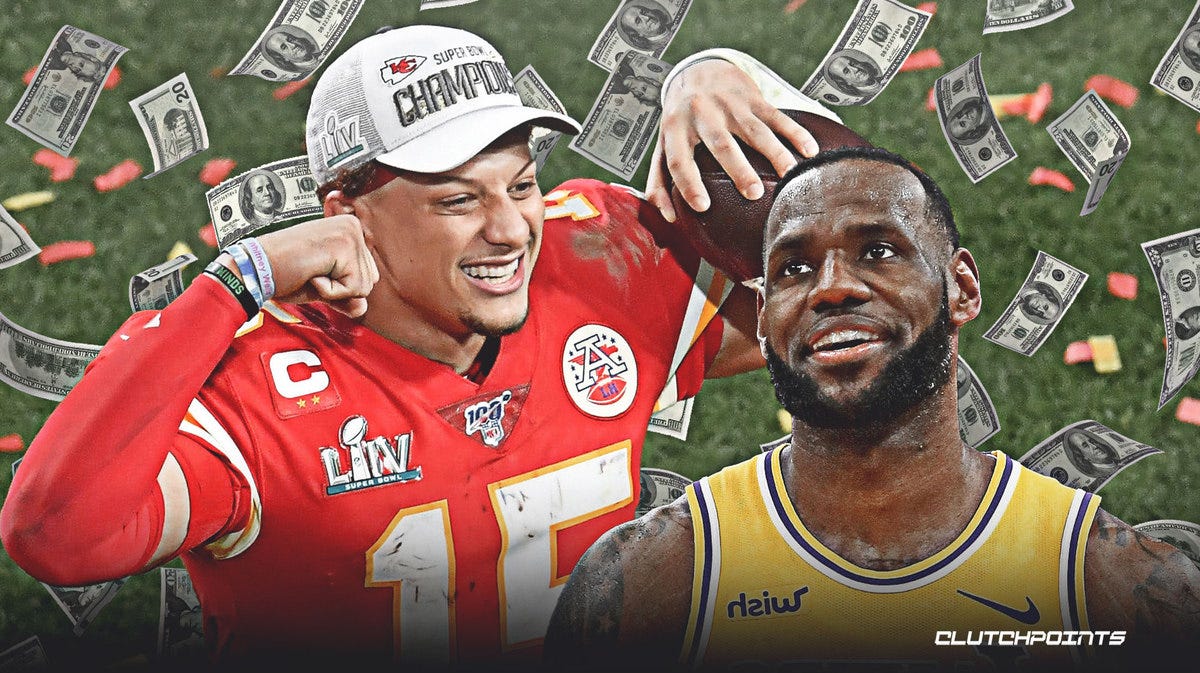
PODCAST RECOMMENDATION
Interested in a companion podcast discussion on decision-making in sports? Check out this conversation between Ben Taylor and Daniel Peterson on a recent Thinking Basketball podcast, where they focus on deliberate skill-development and cognitive skills like attention, working memory, and the impact of emotion.
Follow @BeyondTheRK on Twitter, Substack, and YouTube for all things Orlando Magic and more NBA analysis, data visualizations, and film breakdowns.

